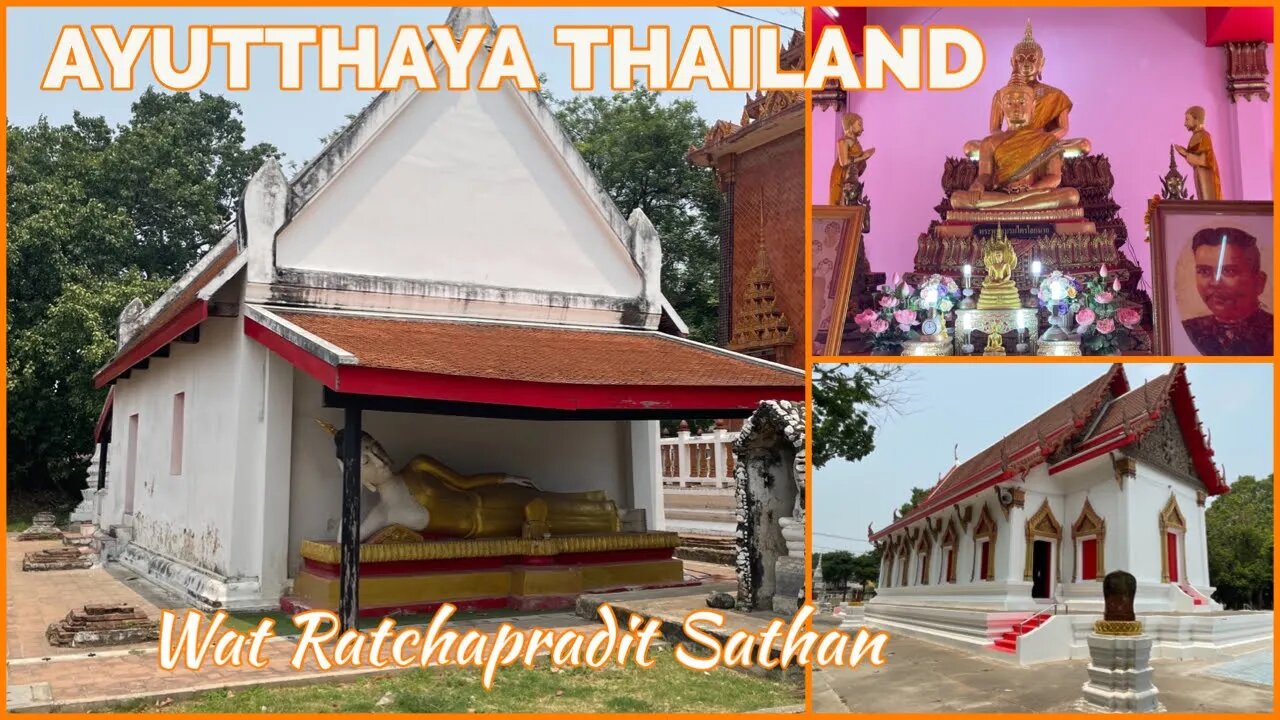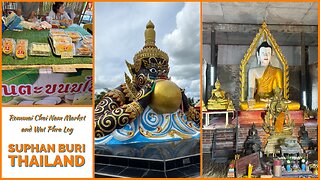Premium Only Content

Wat Ratchapradit Sathan (วัดราชประดิษฐาน) - Wat Tha Sai - Pom Khao Pluak Fort -Ayutthaya 2023
Wat Ratchapradit Sathan (วัดราชประดิษฐาน)
This active temple is located on the city island.
Wat Racha Praditsathan was located next to Khlong Pratu Khao Pluak, which once
separated it from Wat Tha Sai. Traces of a fortress (Pom Khao Pluak) and a water gate (Pratu Khao Pluak) can still be seen in situ. Wat
Tha Sai has since been annexed and is now considered a single temple.
As a fully functioning temple it has been given a modern ordination hall in the Rattanakosin style. There are two old chedi on the northern side of the sermon hall. One has multiple layers with a bell-shaped crown. The second chedi is constructed in the “mango seed” style, which is the only one of its kind in the city.
Wat Racha Praditsathan is closely associated with King Chakkraphat, who served as a monk at this temple prior to accepting the throne. This story dates back to when Queen Regent Si Sudachan and Khun Worawongsa usurped the throne in 1548. Si Sudachan was a concubine of King Chairacha that became Queen Regent after his death. Her 11-year-old son, Yot Fa, was made King, but his reign was short lived. The Queen Regent had her own child executed at Wat Khok Phraya and appointed her lover, Khun Worawongsa as the new monarch. Meanwhile Prince Yot Fa’s uncle,
Prince Thianracha (the future King Chakkraphat) sought political refuge by being
ordained a monk at Wat Racha Praditsathan.
Khun Worawongsa’s ill-fated reign would last only six weeks. A group of assassins ambushed him and Queen Regent Si Sudachan while the couple was having a recreational outing on Khlong Pla Mo. The two usurpers and their baby daughter were taken away to be executed and their corpses publicly displayed at Wat Raeng. The group of assassins then persuaded Prince Thianracha to leave the monk hood in order to become King.
After accepting the throne, King Chakkraphat sent the younger brother of the 11-year-old King Yot Fa - Prince Si Sin - to Wat Racha Praditsathan to be raised as a novice monk. However, as Prince Si Sin became older, he staged a rebellion in order to claim the throne for himself. Prince Si Sin and his supporters attacked the Royal Palace at the Sao Thong Chai gate. This surprise attack forced King Chakkraphat to flee the palace. Eventually, Prince Si Sin was killed in battle by gunfire. As a warning against future rebellions, the prince’s colleagues and some of their wives were executed in public and their bodies impaled and displayed next to the corpse of Prince Si Sin.
WAT THA SAI (วัดท่าทราย)
Although it could be technically classified as a ruin, Wat Tha Sai is now considered part
of Wat Racha Praditsathan’s property.
There are many ancient architectural structures on site. The central chedi resembles a style most commonly associated with the Haripunchai Kingdom. The chedi takes the
shape of an octagonal tower with multiple arched niches that hold standing Buddha
images - several of which can still be seen today. This style of chedi can be seen in
Lamphun, which suggests that this monastery might have had some connection with the
Lanna kingdom. There are at least three chedis in Ayutthaya with a similar style.
Also is situ at Wat Tha Sai are several bell-shaped chedis and dozens of memorial
monuments (with a surprisingly large amount of Chinese headstones). It has several shrines including a reclining Buddha image. A large modern mandapa covered in brown tiles really stands out on the premises.
The history of Wat Tha Sai is unclear. In the Ayutthaya period, it was an important ferry crossing point that was connected to Wat Wong Khong on the other side. This monastery was set in a prime location because of its access to the watergate. Royal Chronicles point out that enemy troops from Lawaek - Cambodia - were posted at Wat Rong Khong Monastery in 1570. Some sources say that it also played a role in this war with Lawaek troops. Locals have claimed that the enemy fired rounds toward the fortress next to it and attempted to collapse the walls in front of this monastery.
Pom Khao Pluak was a fortress standing at Pratu Khao Pluak or the Gate of Unhusked Rice, a water gate. The construction of the bastion was in the form of an open book, located on both sides of the canal. This fortress was one of the many fortresses of the city, of which Pom Phet or the "Diamond Fort" at the confluence of the Chao Phraya and Pa Sak Rivers, was the largest and most important one.
The crenulations on top of the fortress, providing cover for soldiers manning the wall,
are still present and probably designed by Father Tomaso Valguarnera, a Jesuit priest
from Sicily. The city walls, built in the reign of King Narai, were only 1.5 meters wide and 6.5 meters high.
Enjoy the video!
You can also see my videos on Rumble, Bitchute, Odysee and Subscribe Star. If you wish to contact me directly with a question or comment send me an email to endlessjourneytravels@gmail.com
#endlessjourney
#thailand
#travel
-
 14:33
14:33
Endless Journey
1 day agoRommai Chai Nam Market & Wat Phra Loi U-Thong Era Temple - Suphan Buri Thailand 2025
11 -
 22:42
22:42
Liberty Hangout
5 hours agoCollege Democrats Say Gangs Are GOOD!
59514 -
 2:14:50
2:14:50
Badlands Media
11 hours agoBadlands Media Fantasy Football Live Draft
16K -
 2:12:29
2:12:29
Inverted World Live
5 hours agoWe Are Time Travelers | Ep. 100
65.6K10 -
 2:57:09
2:57:09
TimcastIRL
5 hours agoCorporate Press Refuses To Mention Minneapolis Shooter Was Trans | Timcast IRL
170K88 -
 LIVE
LIVE
Akademiks
4 hours agoWar in RAT-LANTA. Young Thug vs Gunna vs Ralo vs YSL MONDO. Who Will Le Bebe Pick. FINAL CRASHOUT!
1,745 watching -
 1:02:24
1:02:24
Man in America
8 hours agoThe Final Battle: Nanotech, Transhumanism & the War for Your Soul w/ Dr. Ed Group
29.5K3 -
 39:56
39:56
Sarah Westall
2 hours agoUpcoming World Wide Economic Collapse/Deep Recession & What the Big Money is Doing w/ Ed Dowd
21.6K3 -
 2:52:55
2:52:55
Barry Cunningham
4 hours agoIT'S MOVIE NIGHT WITH BARRY!
34.5K23 -
 31:05
31:05
The Why Files
2 days agoPeru's Most Terrifying Mystery | The Face Peelers
40.3K41